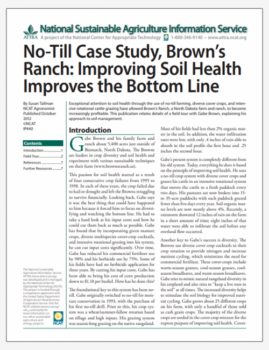No-Till Case Study, Brown’s Ranch: Improving Soil Health Improves the Bottom Line
By Susan Tallman, CCA, NCAT Agronomist
Abstract
Exceptional attention to soil health through the use of no-till farming, diverse cover crops, and intensive rotational cattle grazing have allowed Brown’s Ranch, a North Dakota farm and ranch, to become increasingly profitable. This publication relates details of a field tour with Gabe Brown, explaining his approach to soil management.
Contents
Introduction
Field Tour
References
Further Resources
Introduction
Gabe Brown and his family farm and ranch about 5,400 acres just outside of Bismarck, North Dakota. The Browns are leaders in crop diversity and soil health and experiment with various sustainable techniques on their farm. See the Brown’s Ranch website.
This passion for soil health started as a result of four consecutive crop failures from 1995 to 1998. In each of these years, the crop failed due to hail or drought and left the Browns struggling to survive financially. Looking back, Gabe says it was the best thing that could have happened to him, because it forced him to focus on diversifying and watching the bottom line. He had to take a hard look at his input costs and how he could cut them back as much as possible. Gabe has found that by incorporating green manure crops, diverse multispecies cover crop cocktails, and intensive rotational grazing into his system, he can cut input costs significantly. Over time, Gabe has reduced his commercial fertilizer use by 90% and his herbicide use by 75%. Some of his fields have had no herbicide application for three years. By cutting his input costs, Gabe has been able to bring his cost of corn production down to $1.18 per bushel. How has he done this?
The foundational key to this system has been no-till. Gabe originally switched to no-till for moisture conservation in 1993, with the purchase of his first no-till drill. Prior to this, his crop system was a wheat/summer-fallow rotation based on tillage and high inputs. His grazing system was season-long grazing on the native rangeland. Most of his fields had less than 2% organic matter in the soil. In addition, the water infiltration rates were low, with only .4 inches of rain able to absorb in the soil profile the first hour and .25 inches the second hour.
Gabe’s present system is completely different from his old system. Today, everything he does is based on the principle of improving soil health. He uses a no-till crop system with diverse cover crops and grazes his cattle in an intensive rotational system that moves the cattle to a fresh paddock every two days. His pastures are now broken into 15 to 35 acre paddocks with each paddock grazed fewer than five days every year. Soil organic matter levels are now mostly above 4%. Recently, a rainstorm showered 12 inches of rain on the farm in a short amount of time; eight inches of that water were able to infiltrate the soil before any overland flow occurred.
Another key to Gabe’s success is diversity. The Browns use diverse cover crop cocktails in their crop rotation to provide nitrogen and increase nutrient cycling, which minimizes the need for commercial fertilizer. These cover crops include warm-season grasses, cool-season grasses, cool-season broadleaves, and warm-season broadleaves. Gabe tries to mimic natural rangeland diversity in his cropland and also tries to “keep a live root in the soil” at all times. The increased diversity helps to stimulate the soil biology for improved nutrient cycling. Gabe grows about 25 different crops on his farm, with only a handful of those sold as cash grain crops. The majority of the diverse crops are seeded in the cover-crop mixture for the express purpose of improving soil health. Cover crop mixtures also provide a bridge between cropland and rangeland by furnishing added forage for cattle grazing.
A visit to Gabe’s farm in July 2009 showcased some examples of what he is doing and how he makes it work. The next section relates the story of that visit.
Field Tour
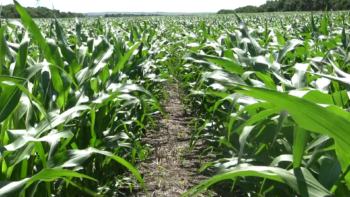
A field of no-till corn with no fertilizer or herbicide. Photo: Susan Tallman, NCAT
Corn Crop
The first field we visit is planted in corn. This field is beautiful and green, with few visible weeds, so it’s a bit of a shock to hear that Gabe hasn’t applied any commercial fertilizer, manure, or herbicide to this field. He plans on harvesting this field for grain corn.
Gabe has been growing corn this way for several years. His yield average is 127 bushels per acre, while the county average is 100 bushels per acre. As his system is becoming healthier, he is using progressively lower amounts of inputs. Gabe uses tissue analysis as the primary way to gauge the health of his crops. A recent tissue analysis of his corn shows the corn is sufficient or high in all the nutrients tested.
In 2008, he was able to compare two different fields of corn on his farm. One was grown with off-farm inputs and one was grown without. (See Table 1.)
| Table 1. Comparison of Fertilized and Unfertilized Corn Field Yields | ||
| Fertilized Corn | Unfertilized Corn | |
| Commercial Fertilizer | 100 pounds/acre 46-0-0 | None |
| Manure | 20 tons/acre – Fall ‘07 | 20 tons/acre – Fall ‘07 |
| Yield | 114.6 bu/acre | 114.8 bu/acre |
| Note: Precipitation in 2008 as recorded at the Bismarck, North Dakota, airport was 18.71 inches. | ||

No-till soil structure with good aggregation. Photo: Susan Tallman, NCAT
At this point in the visit, we dig into the soil with a spade and bring up a beautiful spadeful of dark soil. It has good aggregate structure, with a soft “cottage cheese” texture.
Earthworms are crawling all through the soil. There is still a noticeable tillage layer, even after 16 years of no-till. Gabe expects this will continue to decrease gradually. The top six inches of the soil is where the current improvement is, but the improvement will continue through the profile over time.
Corn with Underseeded Hairy Vetch
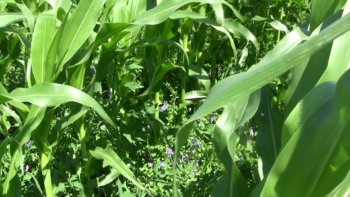
No-till corn underseeded with hairy vetch. Photo: Susan Tallman
One of Gabe’s goals is to move away from monoculture crop production. With that in mind, we next visit the field across the road. This corn field is different than the first: it’s an experiment Gabe is trying of corn underseeded with hairy vetch.
Gabe seeded this field with winter triticale and hairy vetch in the fall. Then in the spring, the day before corn seeding, he applied a light application of glyphosate, knowing it would kill the triticale and not the hairy vetch. Next, he seeded corn into the hairy vetch with a no-till drill. The glyphosate suppressed the hairy vetch, which gave the corn a chance to canopy. Now, in mid-summer, the hairy vetch is coming back and will fix nitrogen to improve the soil. No fertilizer was applied to this field for this corn crop.

Worm castings. Photo: Susan Tallman, NCAT
One thing we immediately notice as we walk through this field is a solid mat of worm castings on the surface of the soil.
“Last winter,” notes Gabe, “because of the large amount of snow, we made some passes through with the tractor so it would hold the snow before it blew on the road. Wherever I did that, the deer camped out and we got significant weed pressure.”
After the corn is harvested for grain in the fall, the corn residue and hairy vetch will be grazed by cattle in late November and early December. The corn stalks will provide carbohydrate energy and the vetch will provide protein. One thing Gabe likes about hairy vetch is that it stays green for a long time and continues to put on blooms late into the season. In fact, hairy vetch flowers all through the season. These plants have buds, flowers and seeds all at once, and will keep going like that until the fall. It has to get really cold to kill vetch, and the vetch provides an excellent ground cover to protect the soil. Hairy vetch is a biannual. Because this planting was seeded last fall, it will have run its life cycle by the coming winter, and won’t come back in the spring.
Next year on this field, Gabe will probably plant a cool-season forage mixture. He likes to follow the corn with peas or something similar that can put up with cold temperatures and come through the heavy corn residue.
Forage Crop
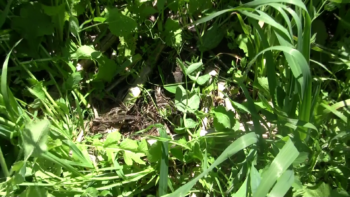
Corn residue from the previous year in the cool-season forage cover crop mixture. Photo: Susan Tallman, NCAT
In an adjacent forage field, Gabe has a multispecies mix of oats (cv. Everleaf), peas (cv. Arvika), radish, turnip, red clover, and hairy vetch. The Browns have used this mixture in the past, and it has worked very well for them. This mix was seeded on May 15, a bit later than Gabe would have liked, due to the wet spring. Last year, this field produced grain corn. Gabe used no herbicide or fertilizer on this field.
There are a few weeds in the field, but they aren’t a problem, since this field will be green-chopped in three weeks, before the weeds have a chance to go to seed. Gabe hopes the vetch, red clover, and turnips will come back after this initial harvest and will provide grazing forage for the fall. If not, he will seed another cover crop in the fall, because he tries to have a living root in the soil at all times.
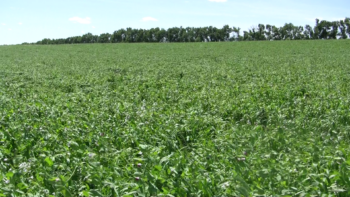
Cool-season forage cover-crop mixture. Photo: Susan Tallman, NCAT
The Browns have moved away from including corn silage in their rotation. They believe it takes too much residue off the soil, leaving the ground exposed to potential erosion. This new forage cover crop mix, by contrast, provides more ground cover, as the various structures of the plants grow out and cover the entire soil surface.
The forage quality of the mix is comparable to that of corn silage. The mix provides a little more protein than corn silage but has a little less carbohydrate. Meanwhile, the mix yields almost as much tonnage as the corn silage. Another advantage of the forage cover crop mixture is that the Browns can grow two crops in one growing season, instead of just one corn crop.
During the tour, we take a spade of this field’s soil and note the great soil structure and large number of worms. There is a lot of residue decomposition going on at the soil surface and a high level of biological activity in this soil. Worm pathways are one reason the infiltration rate is so high, because they allow water to percolate down through the soil rather than running off on the surface.
Gabe has increased his soil organic matter (SOM) on this land over the years, so that its water-holding capacity has gotten much larger. On this field, the SOM level is between 4.2 and 4.4%. When Gabe began no-till farming 16 years prior, it was between 1.7 and 1.9%. In a few fields, the SOM level was as low as 1.3%.
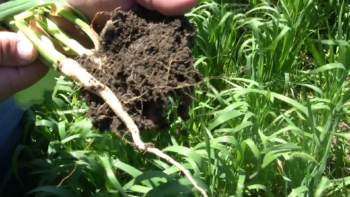
Shape of a radish indicates the plow layer. Photo: Susan Tallman, NCAT
While visiting this field, we dig up a radish and notice it is angled towards the base, where it met the old tillage layer. The radish root did work its way through the plow pan, even though it took some effort. In contrast, a fibrous root crop would have perched on top of the old plow layer without drilling through it. After this radish root decomposes, it will leave a channel through the soil for improved water infiltration. This activity of the radish is known as “bio-drilling.”
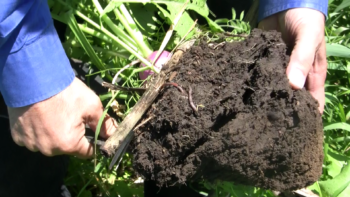
A deep-tap-rooted turnip from the forage cover crop. Photo: Susan Tallman, NCAT
We then dig up a turnip. The turnip root isn’t as aggressive as the radish root, but it still adds value in the soil profile. So why would anyone plant turnips and radishes together? Wouldn’t one or the other do just as well? Gabe says that one goal he has for these mixes is for the roots to cover every area of the soil profile. The oats are a shallow, fibrous-rooted crop; the hairy vetch is a shallow-rooted legume crop, the red clover is a medium-rooted legume, and turnips and radishes are deeper-tap-rooted brassicas. Each lives in a different depth of the soil profile. When these plants die, their roots will increase soil organic matter throughout the entire soil profile. Even though radish and turnip are similar plants, the roots are different shapes and cover different areas of the soil. Also, planting them together reduces the risk of failure due to pests or disease. Planting both increases the chance that at least one will survive and provide a taproot in the soil.
Transitioning Out of CRP with Cover Crops
The next field is in transition out of the Conservation Reserve Program (CRP). For 20 years, this field has been mainly smooth brome, with a little alfalfa mixed in. In recent years, the land was becoming a noxious weed mess. Gabe is leasing it from his neighbor for the same price the neighbor would receive for keeping it in CRP.
Gabe hayed the field in June 2008 and then no-till seeded a hairy vetch and winter triticale cover crop. Gabe was careful not to disturb the soil structure when preparing the seedbed. He disced prior to seeding, but set the blades to run above the soil surface, just enough to shear off the pocket-gopher mounds. He then went through with a roller to smooth the surface further. Gabe says that so many people grab the disc when taking land out of CRP, run the disc deep, and in the process destroy soil structure that is the product of 20 years of zero tillage. By contrast, he wanted to maintain the soil health benefits of the land’s time in CRP. Gabe intentionally didn’t fertilize this field with any commercial fertilizer because he wanted the soil to produce for itself. He knew it was going to be short of nitrogen, and the crop did look deficient in the spring. Once the vetch got up and going, however, the crop began to look much better.
This field will be combined at the end of August. Gabe will combine the triticale and vetch together and then separate the seed afterwards. He has never done this before and at the time of our visit is unsure of how it will work. Vetch needs to be grown with a crop such as rye or triticale if it’s going to be harvested for seed. Otherwise, the vetch grows too low to the ground and the combine won’t pick it up. If you lifted this vetch up to its full height, it would be four feet tall. The triticale gives it structure and something to grow up.
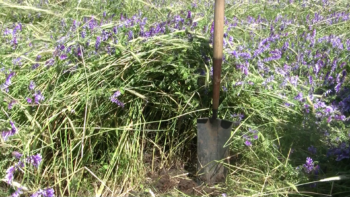
Triticale and hairy vetch interseeded in former CRP field. Photo: Susan Tallman, NCAT
After he combines this crop in the first part of August, Gabe will plant another cover crop cocktail. He will let this second cover crop winter-kill. The purpose of this crop is to promote nutrient cycling. It will not be grazed or harvested in any way. Next year, he may plant a combination of oats and peas. He definitely wants another year of cover crops before planting corn. His goal is not to have to fertilize the first corn crop.
For a typical cover crop mix, Gabe would seed 90 pounds of winter triticale with 15 pounds of vetch per acre. On this field, however, he seeded 60 pounds of winter triticale and 20 to 25 pounds of vetch, knowing that he wanted to increase the nitrogen production. For most of his cover crop mixes, Gabe says he uses the “Simple Wild Guess” technique to determine the mix and rates. It’s a mix of art and science; you have to develop a feel for it. He tries to ask himself, “What do I want to do with this piece of land?” and then develops a cover crop for it, rather than trying to get a specific mix to fit a certain piece of land.
For example, Gabe purchased some land in 1999 that isn’t as developed as the land with the corn fields that we already visited. This newer land has lower organic matter than his other fields, so he’s trying to add more carbon and fibrous root systems to build organic matter. In addition, this field has poor water infiltration, so in the cover crop mix for it he plants a greater proportion of the deep-rooted crops such as turnip and radish.
Gabe explains that one of the difficulties with CRP land is that there is a “duff” layer of old residue. This prevents water from going into the soil and ties up nutrients. He wants to break this duff layer down to get the nutrients cycling through the system. Currently, the land has too much high-carbon residue. The purpose of the triticale-and-hairy-vetch mixture is to provide a source of income from the triticale that is harvested as grain or forage, while simultaneously providing a low-carbon residue from the vetch to break down the old duff layer.
Gabe likes this triticale-and-hairy-vetch cover crop because it gives him options. He can hay it. He can combine it for seed. Or he could graze it. He likes to keep his system flexible. He uses triticale because it is more palatable to livestock than rye. It also has a little more protein. The cattle don’t relish it, but they will eat it as a haylage when the winter gets cold.
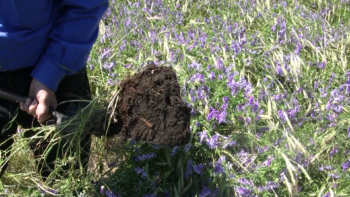
A former CRP field has less soil aggregation than crop fields. Photo: Susan Tallman, NCAT
In the field being transitioned from CRP, we take a look at the soil structure and dig in with the spade. This field hasn’t been tilled for 20 years and there isn’t nearly the predominant horizontal tillage layer that there was in the corn fields. However, the soil doesn’t have the nice aggregate structure in the top layer that the corn fields did. There is more of a solid mass of mineral soil. In addition, we notice no earthworms in this field. Gabe speculates that there are few worms in the CRP land because while this field was in CRP it lacked diversity. It was smooth brome with a little alfalfa and crested wheat grass for 20 years, and this near-monoculture provided little biological stimulation. There was no combination of various plant functional groups.
Gabe talks about the importance of balancing the bacterial and fungal portions of the soil food web. His goal is to bring the ratio of bacterial portion to fungal portion close to 1:1, and he is experimenting for the first time with compost tea applications on some of his fields to boost the fungal portion. (The first field of corn we observed received a compost-tea application this year.) He currently has some fields close to the 1:1 ratio and believes that when this ratio is attained he has lower weed pressure, improved nutrient cycling, and a more aerobic soil to stimulate soil microbiological processes. He also believes that his soil organic matter could someday be as high as 6 or 7%, which is close to what the native rangeland in the area had prior to agricultural cultivation.
Gabe tests his soil every year. The main indicator he monitors from these tests is the organic matter. He would like to do more soil-food-web testing, because they currently do not do this every year. However, they do regularly perform a nutrient analysis on their crop plants. Gabe feels that if the plant tissue analysis shows healthy plants, then the soil must have enough nutrients.
During the visit, Gabe talks about the improved efficiencies of no-till. The old summerfallow-wheat rotation wasn’t very efficient in precipitation use. Research from numerous locations showed that most of these systems only kept about 25% of the available precipitation that fell in the fallow year (Farahani et al., 1998). Increasing the cropping intensity, plus using no-till, allows for precipitation to be used more efficiently. As a no-till system develops, more soil aggregates are built, and the water storage and efficiency both increase. Gabe says it’s just a whole different cropping scheme and it is remarkable to see.
Gabe started no-till to save moisture, time, and fuel. He believes that water is not nearly as limiting of a resource for him now that he uses no-till, and believes no-till to be a big tool to help survive a drought. In 2004, he had an alfalfa field that had been in for about five years. He took it out and no-till planted corn into the alfalfa residue. It was a very dry year, with only 11 total inches of precipitation. Gabe harvested a corn crop of 177 bushels per acre off that field. There wasn’t a lot of subsoil moisture; the system was just efficient in retaining the moisture that was there.
The Brown Cattle Herd
A key part of the sustainability of Brown’s Ranch is the cattle herd. The cattle eat the forage from the cropland, and in return provide manure for fertility. In addition, the cattle give Gabe one more tool in his Diversity Toolbox.
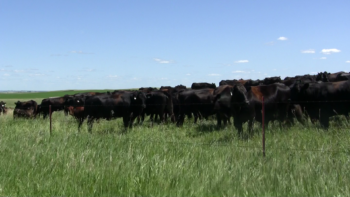
Brown’s Ranch cattle. Photo: Susan Tallman, NCAT
Next in our tour, we head to a nearby pasture where cows are grazing. The Browns raise Balancer® cattle, a cross between Angus and Gelbvieh. They run about 400 cow-calf pairs and 200 to 600 yearlings at any given time.
The Browns used to practice seasonal grazing over the area of an entire large pasture. They had about five large pastures, spread over many acres. This system limited their cattle stocking because it did not allow enough rest time for adequate regrowth of the native rangeland.
Then the Browns started to practice intensive mob grazing. They now have many paddocks of 15 to 35 acres each, which are divided further into smaller paddocks to graze 325 heifers at one time. By doing this, they are able to increase their stocking density to 685,000 pounds of liveweight per acre. The cattle are moved once to several times per day and are allowed to consume 30 to 40% of the aboveground plant biomass in each paddock. Each paddock is grazed only once or twice each year.
Water is the key to making this system work. The Browns put a well on the top of the hill and have shallow pipelines running to every pasture. This system brings fresh water to each pasture.
The higher stocking rates directly improve soil health. Native plant species evolved with this type of grazing from the buffalo. Intensive mob grazing provides more hoof impact. This tramples the plant residue, making it easier to break down, and brings it in contact with the soil surface so the soil biology can cycle it through the system. In addition, the higher stocking rates provide for more even distribution of manure. It is spread over the entire paddock, which also improves nutrient cycling.
One of the benefits of moving his cattle so frequently is that Gabe’s cows no longer need to be sprayed for fly control. (The cattle in the photos have no fly control.) An adult fly will only travel 100 yards from where it was born. If the cows are more than 100 yards away when the fly hatches, the fly can’t find them. So this grazing system is more sustainable from a pest management perspective. However, a problem arises if the intensively grazed pasture is next to a neighbor who seasonally grazes, because his neighboring field can be a source of flies.
Gabe’s philosophy is that everything Brown’s Ranch does has the resource’s best interest placed first. The Brown family believes that attention and investment in soil health reaps long-term benefits for the land and for the bottom line. As Gabe says “Don’t complain about input costs, do something about it! Diversify!”
References
Farahani, H. J., G. A. Peterson, and D. G. Westfall. 1998. Dryland cropping intensification: A fundamental solution to efficient use of precipitation. Advances in Agronomy. Vol. 64. p. 197-223.
Further Resources
Burleigh County Soil Conservation District
USDA-ARS, Mandan North Dakota, Cover Crop Selection Chart
No-Till Case Study, Brown’s Ranch: Improving Soil Health Improves the Bottom Line
By Susan Tallman, NCAT Agronomist
Published October 2012
© NCAT
IP440
Slot 445
This publication is produced by the National Center for Appropriate Technology through the ATTRA Sustainable Agriculture program, under a cooperative agreement with USDA Rural Development. ATTRA.NCAT.ORG.

